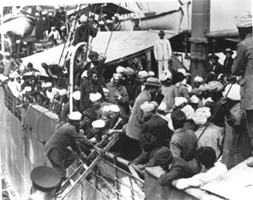
|
The legal wrangling went on for two month, at considerable expense to the Sikh community. The shore committee spent over
On July 23,1914, the Komagata Maru was escorted out of Canadian waters by the Rainbow and left for India with its
There were serious repercussions in Canada as well. The entire Sikh community in British Columbia was devastated by the departure of the Komagata Maru. Morale was at an all-time low as most Sikhs lost faith in Canada and its institutions. Their economic resources were depleted and a split in the Vancouver Sikh community developed. Many Sikhs died in the communal in fighting. A corrupt immigration official, William Hopkinson, was shot to death and a Sikh named Mewa Singh was hanged for his murder. In the aftermath, many Sikhs were so upset by the recent events and the attitude of the Canadian government that they went back to India to help overthrow British rule. They felt that their situation Canada would not improve until they had their independence in India. Many others went to the United States in search of better social and economic conditions. By 1918, the Sikh population in British Columbia had dropped to a low of 700 people. These were the survivors who weathered the storm and remained here when the future looked bleakest. The numerous challenges to the immigration bar, the infamous Komagata Maru incident, the many legal maneuverings and the injustices they faced on a daily basis had left them sad and disillusioned. So they banded together and became stronger as a community, with the temple becoming a substitute for the family life that they were all lacking. With community rebuilding, group solidarity and religious devotion, they would win the fight against oppression. The temple was their headquarters; every strategy and ploy was planned there. The Khalsa Diwan society was the collective agency that coordinated and spearheaded all activity, now having temples in Vancouver, Victoria, New Westminster, Fraser Mills, Golden, Abbotsford and Paldi. The collective efforts of British Columbia’s Sikh communities eventually paid off when, in 1919, the immigration restrictions on bringing out wives and children under eighteen years old were lifted. Family reunification would be a very slow process - it was not until 1920 that women and children started coming out from India - but the Sikhs finally had a sense of hope for their future in Canada. |
Next Section...







